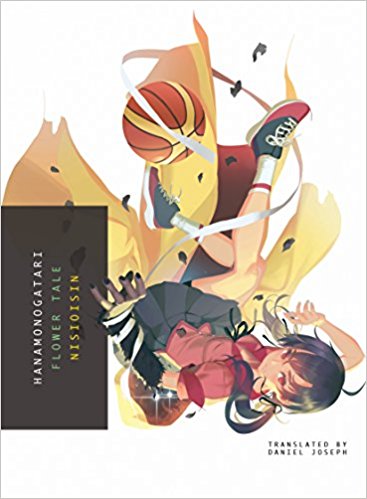By NISIOISIN and VOFAN. Released in Japan by Kodansha. Released in North America by Vertical, Inc. Translated by Daniel Joseph.
First off, I can’t help but notice that I haven’t been crediting VOFAN in my reviews of the Monogatari series. This may not be surprising – Monogatari is not a “light” novel per se, and there are no interstitial illustrations – we get cover art and one large piece at the start of the story. But the art is not only gorgeous but can also be a signpost as to what type of story we’re getting. Kanbaru here – be it in the original cover or the one VOFAN did for the North American release – is looking very serious, not at all like the suggestive and leering girl we’ve seen in previous books narrated by Araragi. And sure enough, as we get a book written with her narration, we see that she is at heart an overly serious and earnest young woman, and that most of her banter with Araragi is a facade. “Playing the fool” is something she’s actively called out about. Even worse, this book takes place in her third year, so she can’t even count on her (now graduated) friends.
That’s right, we’re jumping forward in this book, as Hanamonogatari takes place sometime after the events of all the other books in the series. Araragi, Senjogahara and Hanekawa have graduated and moved on – though Araragi does play a small role here, mostly to give Kanbaru emotional support. Which she desperately needs. Her friend Higasa knows nothing of aberrations. Kaiki Deishu shows up, oddly enough, claiming to know her mother, and is actually quite helpful, but given his behavior regarding Senjogahara, Kanbaru wants nothing to do with him. And then there’s Ogi (and believe me, that romanization pains me as much as it does you). I hadn’t mentioned Ogi in my review of Kabukimonogatari – she showed up at the start to harangue Araragi about stoplights, and seems to hold him in contempt. Now Ogi is a male student – this is lampshaded a few times in case we don’t get the gender switch – and haranguing Kanbaru, though there seems to be less venom in his tone this time around. Ogi is clearly a puzzle that we’ll have to solve in future books, but for now let’s just go with ‘annoying underclassman’.
As for the main plotline, you won’t be surprised to hear it has to do with Kanbaru’s main issues – her “devil’s hand” and basketball. An old middle-school rival, Roka Numachi, has shown up, and like Kanbaru she’s injured and doesn’t play anymore. Also like Kanbaru she seems to be somewhat fluid in her sexuality, though this book indicates that most of Kanbaru’s happy “I’m a lesbian!” to Araragi was part of her front – her experience is near zero, though there’s definitely sexual tension with Roka. As with a lot of the Monogatari series, the plot itself seems to be laid out in a couple of long expository monologues – if you get bored easily, this is not the series for you. The resolution works well, though, and seems to point to Kanbaru maturing and moving forward, made explicit by her cutting her hair short again at the end (it has been growing longer as the series has gone on, as anime fans no doubt noticed.)
Anime fans, speaking of which, may be surprised to see this book coming so soon – this was the original Japanese release order, but the anime delayed its production till after the next three books were adapted. If you like Kanbaru it’s essential, and even if you don’t it’s still a good volume of the series, mostly as it lacks the “filter” of Araragi’s narration. Next time we’ll move back a few months and see why Sengoku Nadeko is this series’ most polarizing character.

